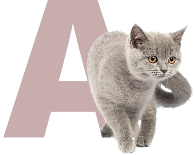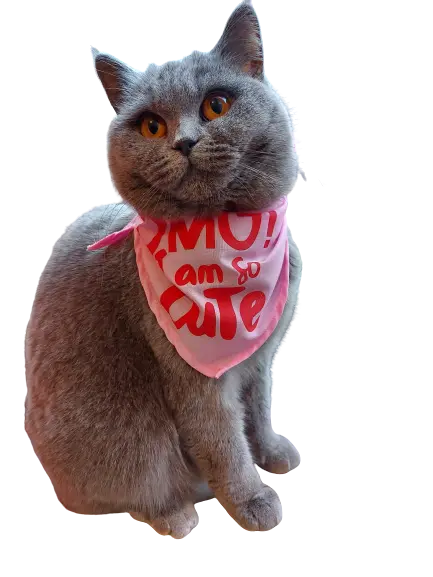The Great British Shorthair

British shorthair is one of the most popular cat breeds in the world. Not only do they have a thick, plush short coat, they also have a friendly yet no-nonsense—that is, rather British—sensibility about life. British shorthair make ideal family cats and enjoy being with their owners, but may turn up their noses at being held or cuddled too much.
History
British Shorthair traces its roots back to Rome. Cats brought by Roman invaders would have had to be tough, clever, weather-proof, and hardy, to survive the journey and to breed with the native wildcats! Once on British soil, they made themselves at home and eventually began to be selectively bred for their rounded and appealing appearance, and affectionate nature. First recorded as the British Shorthair in 1870, the breed has been popular ever since.
The British Shorthair, coming from the farms and streets of Britain, is also considered to be the first cat of the cat fancy. The “father” of this breed is Harrison Wier, who is thought of as the first professional cat breeder. He is known in cat fancy history as the “Father of the Cat Fancy.” Not only he was the first professional breeder, but he also determined the rules for the first cat show, which was held in Britain in 1871.The British Shorthair became an officially acknowledged breed by 1889 and went on to become one of the most popular breeds in cat shows at that time and still are today.

During the Second World War, as in the First World War, the British Shorthair breed was decimated, but it always reemerged into the top ranks of popularity. Today, the British Shorthair is accepted in cat registries worldwide. At one time, it was known as the British Blue, but since it comes in a variety of colors, it is called either the British or the British Shorthair.
General Appearance
The British Shorthair cat is medium to large in size, well balanced and powerful, showing a good depth of body, a full broad chest, strong short legs, rounded paws, tail thick at base with a rounded tip. The head is round, round cheeks, firm chin, large round, well-opened eyes and a short broad nose. The coat is short and dense.
The coat of the British is thick and dense. It becomes much longer and thicker during the winter. The texture of the coat is relatively hard, as it is meant as protection for the cat.
When you pick up a British, you should always support her back end. British should not have their hind end drag down their abdomen, as this can make them uncomfortable and insecure.
Personality
British Shorthair are placid, not demanding, tolerant, docile and respectful. They are not vocal cats and in fact are very quiet and can cope with being alone without fretting. They are not inclined to wander. They love children and get along extremely well with dogs. They are fiercely loyal and a good companion for single people.
British Shorthair is a very companionable cat with family, although like many cats they may take a little time to warm up to strangers.
Care
Unlike long-haired cats, British Shorthair don’t need to be fussed over to look good. Their short, soft, dense coat only requires weekly brushing to remove dead hair and skin cells. But for the most part, they do a good job keeping themselves clean and tidy.
Like other breeds, British Shorthair need frequent nail trims and dental care, as well as regular trips to the veterinarian. Be sure to spay or neuter your pet and keep their vaccinations up to date, as instructed by vet. Check their ears regularly for wax build-up or possible ear mites as well. It’s also important to keep their litter boxes clean so they don’t turn their nose up at it.
Health
British Shorthair are a large, healthy breed that can live up to 20 years. However, they are susceptible to certain health problems, as all breeds are.
These kitties can be prone to a condition called hypertrophy cardiomyopathy, which is a thickening of the muscular walls of the cat’s heart; this causes difficulty breathing, lethargy, and loss of appetite in older animals. And, similar to other breeds, British Shorthair can develop urinary tract and kidney issues.
To help prevent health problems from developing, start by getting your British Shorthair kitten from a reputable breeder who uses healthy adults. And always take your cat to your vet once a year for a check-up.
In addition to regular health check-ups, exercise should play an important role in your British Shorthair life. These cats save energy but aren’t that active, so they can gain too much weight (especially in their later years) unless you develop strategies that keep them moving when they’re young. Interactive toys, fishing wands, balls, lasers, and climbing structures like cat trees and cat shelves will all help keep your British Shorthair fit and trim, physically and mentally.
Facts
British Shorthair are the ideal choice as a house cat. The average life span of these cats is 15-20 years, although many live past that age. They are a very hardy cat. British Shorthair can be bred in over 30 different colors, although some colors are not readily available.
⮞British Shorthair may have served as inspiration for Lewis Carroll’s Cheshire Cat in the 1865 ‘Alice in Wonderland’ novel. The way the cat is described in the book as ‘smiling’ best resembles the peculiar shape of a British Shorthair’s mouth.
⮞There’s no saying for sure, but many agree that the cat from ‘Puss in Boots’ is also based on a British Shorthair, given his chubby cheeks and the adorable big eyes that could melt anyone’s heart. The fact that he’s speaking Spanish, though, doesn’t do much to prove this theory.

